AMD Socket-AM2: Same Performance, Faster Memory, Lower Power
by Anand Lal Shimpi on May 23, 2006 12:14 PM EST- Posted in
- CPUs
How Does the New 4000+ Stack Up?
Today AMD is also introducing a new X2, the Athlon 64 X2 4000+. Running at 2.0GHz but equipped with a 1MB L2 cache, the X2 4000+ fits nicely in between the X2 3800+ and the X2 4200+. Its pricing is also in between the two chips, coming in at $25 more than a X2 3800+ and $37 less than the X2 4200+.
The closest competition from Intel, after its recent price cuts, is the Pentium D 950. Clocked at 3.4GHz and armed with a 2MB L2 cache per core, the Pentium D 950 is priced at $316 in 1,000 unit quantities putting it in between the X2 4000+'s $328 and the X2 3800+'s $303 price tag.
3D Rendering - Cinebench 9.5
Our first benchmark is a 3D rendering test using Cinebench 9.5. We focused on the multi-threaded CPU rendering scores since we're primarily testing dual-core CPUs here. The benchmark reports performance in its own Cinebench units, but the important thing is that higher numbers mean better performance.

Cinebench 9.5 shows absolutely no performance difference between the 3800+ and the 4000+, indicating that the 512KB of L2 cache per core is sufficient for the dataset used in this test (alternatively it could be that even a 1MB L2 cache isn't big enough to hold the working dataset). The end result is that since the 3800+ and the 4000+ feature the same clock speed, in situations where a larger L2 cache isn't helpful we'll see absolutely no performance difference between the two processors. Combine this with the possibility that 512KB parts perform better on AM2 than they did on 939 and we start off seeing very little need to recommend the 4000+ over the cheaper 3800+.
3D Rendering - 3dsmax 7
Our next 3D rendering test has been around for a while on AnandTech, it's the 3dsmax 7 SPECapc test that we've used in past CPU reviews. The results we're reporting here are the SPECapc composite scores which are a geometric mean of four rendering tests and scaled against a set of reference scores that are included with the SPECapc benchmark package.

Once again we see basically no performance difference between the 3800+ and the 4000+, proving that clock speed is all that matters here with the Athlon 64 X2. Unlike the Cinebench test however, the Pentium D 950 is able to take the performance lead. Intel's Pentium D architecture continues to be quite competitive in 3D rendering and media encoding tasks as we're about to see.
Video Encoding - DivX 6.1.1 Pro
Next up to bat is DivX 6.1.1 Pro, once again a benchmark used in previous CPU reviews. Our testing methodologies haven't changed, so let's take a look at the results.
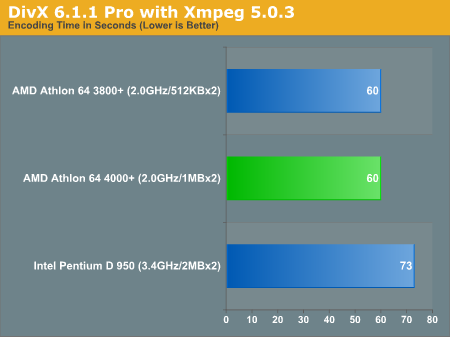
DivX performance is extremely strong with the Athlon 64 X2 4000+ and 3800+, but once again we see absolutely no performance difference between the two CPUs. Both AMD offerings are able to significantly outperform the Pentium D 950.
Video Encoding - Windows Media Encoder 9
While H.264 is the way of the future for video encoding, the vast majority of content today is still encoded in MPEG-2, DivX or using Microsoft's Windows Media Encoder codecs. Just as in previous reviews we're using the Advanced Profile enabled by installing Media Player 10 alongside WME9 which allows for better video quality options and as a result ends up stressing dual-core CPUs even more.
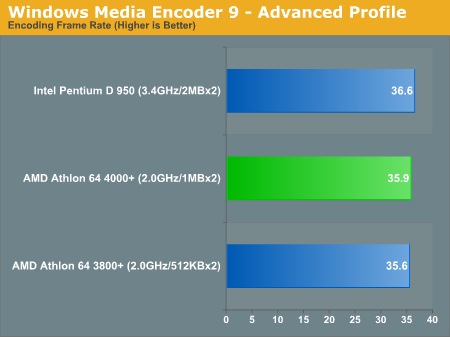
The Athlon 64 X2 4000+ manages to pull slightly ahead of the 3800+, but the two are basically tied. The Pentium D 950 is far more competitive in the WME9 test but isn't tangibly faster than the X2 4000+.
Video Encoding - Quicktime Pro 7.0.4 (H.264)
Until we get support for GPU accelerated H.264 encoding and/or faster CPUs, the number of H.264 encoding applications will remain quite limited. Apple's Quicktime Movie Trailers site has a great deal of H.264 encoded content and using Quicktime 7.0.4 you can generate the same quality, bitrate and file size of content. This is the same test we've run in the past, re-encoding the SD Quicktime movie trailer for Hoodwinked using the H.264 codec. All of the encoding settings were left at their defaults.
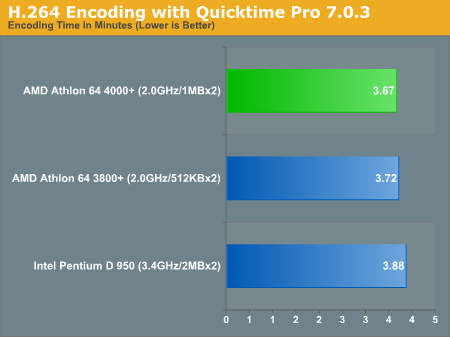
We continue to see a very small performance advantage for the Athlon 64 X2 4000+ but it's nothing worth writing home about, the X2 3800+ is just as good. The Pentium D 950 continues to be a close competitor but definitely isn't any faster than the two AMD solutions.
MP3 Encoding - iTunes 6.0.1.4
Almost a decade ago MP3 playback and encoding could bring even the fastest system to its knees, but today we can encode a 300MB wav into a 192 kbps MP3 in far less than a minute. We left all settings on their defaults except that we did not allow iTunes to play back the song while importing.
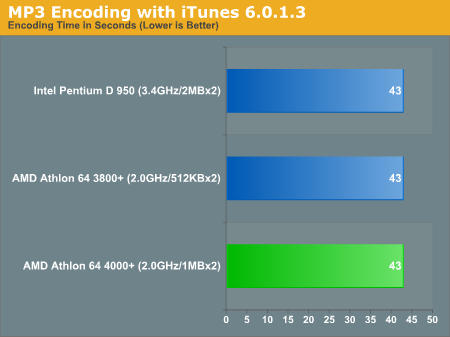
Given the nature of MP3 encoding it's not a surprise that there's no performance difference between the 4000+ and 3800+, but there's also no difference in performance between the AMD solutions and the Pentium D 950.
Gaming - Quake 4 1.1
With the later versions of Quake 4, id Software implemented multi-core support and we saw some pretty impressive performance gains on dual-core CPUs. As always we ran at the game's built in High Quality settings at a resolution of 1024 x 768; SMP was of course enabled.
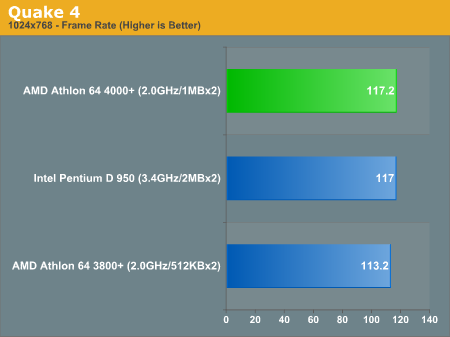
Just as we saw performance differences between AM2 and 939 in games, we see a difference between the 4000+ and 3800+ in these very same games. The fact that the AM2 platform sees a performance gain in 3D games indicates that they are noticeably more memory bandwidth dependent than other applications, and thus we see a benefit to the 4000+'s larger L2 cache. The Pentium D 950 does surprisingly well here, especially considering Intel's very poor reputation for gaming performance.
Gaming - F.E.A.R.
With the graphics options set to F.E.A.R.'s default High Quality and the computer settings at Maximum, we ran the built in F.E.A.R. benchmark reporting average frame rate.
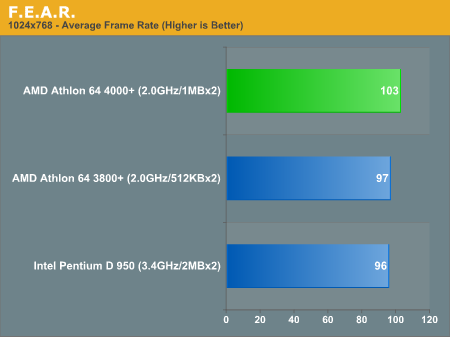
The Athlon 64 X2 4000+ holds a 6% performance advantage over the 3800+ thanks to its larger L2 cache, which continues to make a reasonable difference in our gaming tests. The Pentium D 950 is nipping at the heels of the 3800+, but the 4000+ is untouched at the top here.
Gaming - Oblivion
Our final gaming benchmark uses Oblivion at the same quality settings we used in our recent Oblivion CPU comparison, the only difference is that we ran at 1024 x 768 to make this more of a CPU test and less of a GPU test. We used our Oblivion Town benchmark and reported the average frame rate obtained using FRAPS.
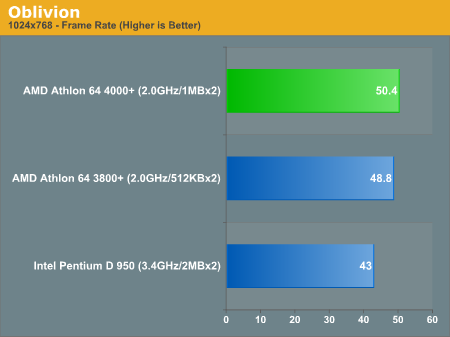
As we saw in our Oblivion CPU comparison, this game really favors AMD's K8 architecture for all of its strengths and severely penalizes the Pentium D for its NetBurst roots. The Athlon 64 X2 4000+ does continue to hold a performance advantage over the 3800+, but it isn't as large in Oblivion as we've seen in the previous two games.
So How Does the Athlon 64 X2 4000+ Stack Up?
At the end of the day the Athlon 64 X2 4000+ is still a very nice CPU that doesn't cost that much more than an X2 3800+; however, unless you're a gamer, you can probably get by pocketing the difference and sticking with the extremely competent 3800+. This is one of the unfortunate consequences of AMD's model number system, where a model number increase can be attributed to either a clock speed bump or an increase in cache size - the model number won't always convey true performance.
Surprisingly enough, the Pentium D 950 is extremely competitive here. Since it's built on Intel's new 65nm process the CPU is actually fairly cool compared to Pentium Ds of the past. Competition is good, but with sometimes significantly higher gaming performance, the Athlon 64 X2 still gets our recommendation here.










83 Comments
View All Comments
Slappi - Thursday, May 25, 2006 - link
That is the real question.Very biased these last few months.
I sure hope Conroe can cook dinner and clean my house because if it can't someone has some explaining to do.
lewisc - Thursday, May 25, 2006 - link
How was that review at all biased? AM2 showed very very small improvements over socket 939, Anand said so. Is it biased because the result was not what you wanted? How you could possibly suggest buying a a new platform that has hardly any improvement over a predecessor is beyond me.Slappi - Thursday, May 25, 2006 - link
Just all his talk about Intel the last few months has been really biased. Not necessarily this article.Just my opinion and I really like this site it just seems like someone is being taken care of.
I could be wrong.
clnee55 - Friday, May 26, 2006 - link
I agree in the last few months, AMD has shown that it doesn't have anything ready to compete with Conroe. I certainly can trust Anand's analysis. Your conspiracy theory is full of it.By the way, just how much AMD stock do you own?
EdisonStarfire - Thursday, May 25, 2006 - link
I've owned AMD systems since 1998 starting with an Athlon 600 OEM. I've built several other AMD systems since then. Sure, there is a slight chance Intel had some influence on their test systems anand tested but from seeing other pre-release samples around the web I think its just a case of Intel finally waking up and building a good cpu. I hope AMD has a good answer but if they don't and fooled themselves into thinking Intel didn't have the resources or need to build something (like alot of fanboys do) then they were kidding themselves badly. If the Core 2 Duo chips are the best out when its time to dump my X2 4400 then thats what I will be buying. I know AMD is limited in resources but the Dothan should have been a sign of what was coming and made some revisions with the AM2 release. Let's hope the deerhound cores improvements add about 20% IPC so can keep some good competition going between the two companies.in short... I don't think Anand is being biased about anything. Just my 2 cents.
Thatguy97 - Friday, May 1, 2015 - link
well it sure did and amds dyingThatguy97 - Tuesday, December 27, 2016 - link
Ayyyyy things looking upThatguy97 - Sunday, June 28, 2020 - link
Ayyy AMD is in the lead nowpeternelson - Wednesday, May 24, 2006 - link
I am interested in the changes from 939 to AM2/940 and opteron/940 and SocketF/1207
I would like detailed PINOUTS for these.
eg how many pins are GND, how many power / core power, how many ddr, how many ddr2, how many hypertransport links.
Ideally full pinout not just summary by group function.
Is this information available anywhere or would I have to/my company have to sign an NDA with AMD to obtain it?
ultraCODE - Wednesday, May 24, 2006 - link
Have anyone managed to benchmark new AM2 platform with RightMark RMMA? It shows the real peak speed (I don't trust crappy Sandra) for mem. read/write. Any results highly appreciated. Thanks in advance!Best wishes,
uC